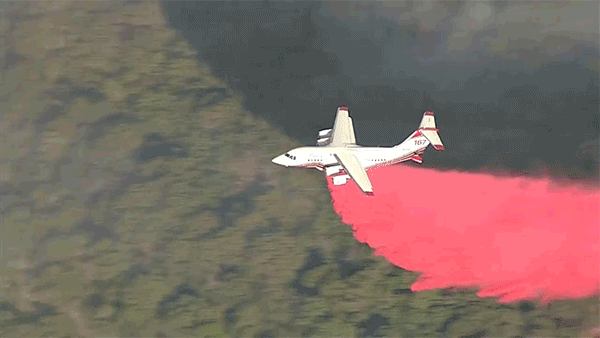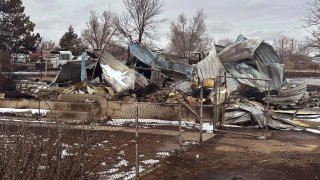
What to know about Texas wildfires
- The Smokehouse Creek fire ignited in the Panhandle on Monday in rough terrain and unfavorable weather conditions and spread with alarming speed.
- The wildfire is the largest in the state's history, burning over 1 million acres.
- Two deaths have been reported; Texas Gov. Greg Abbott issued a disaster declaration on Tuesday.
A dusting of snow covered a desolate landscape of scorched prairie, dead cattle and burned-out homes in the Texas Panhandle on Thursday, giving firefighters brief relief in their desperate efforts to corral a blaze that has grown into the largest in state history.
The Smokehouse Creek fire has grown to nearly 1,700 square miles (1,075,000 acres). It merged with another fire Thursday and was 5% contained on Friday morning, according to the Texas A&M Forest Service. Because precipitation fell on most of the area Thursday, the fire did not grow overnight. The forest service said crews will focus on the northern edge of the fire and areas around structures on Friday.
Get DFW local news, weather forecasts and entertainment stories to your inbox. Sign up for NBC DFW newsletters.
Gray skies loomed over huge scars of blackened earth in a rural area dotted with scrub brush, ranchland, rocky canyons and oil rigs on Thursday. In Stinnett, a town of about 1,600, someone propped up an American flag outside of a destroyed home.
Dylan Phillips, 24, said he hardly recognized his Stinnett neighborhood, which was littered with melted street signs and the charred frames of cars and trucks. His family's home survived, but at least half a dozen others were smoking rubble.
“It was brutal," Phillips said. “The street lights were out. It was nothing but embers and flames.”
The Smokehouse Creek fire's explosive growth slowed Thursday as snow fell and winds and temperatures dipped, but it was still untamed and threatening. It is the largest of several major fires burning in the rural Panhandle section of the state. It has also crossed into Oklahoma.
Firefighter Lee Jones was helping douse the smoldering wreckage of homes in Stinnett to keep them from reigniting when temperatures and winds increase Friday and into the weekend.
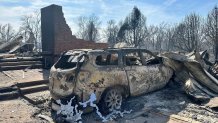
“The snow helps,” said Jones, who was among a dozen firefighters called in from Lubbock to help. “We’re just hitting all the hot spots around town, the houses that have already burned.”
Authorities have not said what ignited the fires, but strong winds, dry grass and unseasonably warm temperatures fed the blazes.
“The rain and the snow is beneficial right now, we’re using it to our advantage,” Texas A&M Forest Service spokesman Juan Rodriguez said of the Smokehouse Creek fire. “When the fire isn’t blowing up and moving very fast, firefighters are able to actually catch up and get to those parts of the fire.”
Authorities said 1,640 square miles (4,248 square kilometers) of the fire were on the Texas side of the border. Previously, the largest fire in recorded state history was the 2006 East Amarillo Complex fire, which burned about 1,400 square miles (3,630 square kilometers) and resulted in 13 deaths.
An 83-year-old woman was the only confirmed death so far this week. But with flames still menacing a wide area, authorities have yet to conduct a thorough search for victims or tally the numerous homes and other structures damaged or destroyed.
Nim Kidd, chief of the Texas Division of Emergency Management, said the weekend forecast and “sheer size and scope” of the blaze are the biggest challenges for firefighters.
“I don’t want the community there to feel a false sense of security that all these fires will not grow anymore,” Kidd said. “This is still a very dynamic situation.”
The woman who died was identified by family members as Joyce Blankenship, a former substitute teacher. Her grandson, Lee Quesada, said he had posted in a community forum asking if anyone could try and locate her. Quesada said deputies told his uncle on Wednesday that they had found Blankenship’s remains in her burned home.
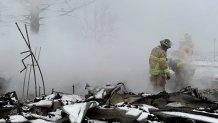
Republican Gov. Greg Abbott issued a disaster declaration for 60 counties. The encroaching flames caused the main facility that disassembles America’s nuclear arsenal to pause operations Tuesday night, but it was open for normal work Wednesday.
The small town of Fritch, north of Amarillo, lost hundreds of homes in a 2014 fire and appeared to be hit hard again. Mayor Tom Ray said Wednesday that an estimated 40-50 homes were destroyed on the southern edge of the town of 2,200.
Hemphill County Emergency Management Coordinator Bill Kendall said about 40 homes were burned near the town of Canadian, and described the charred terrain as being “like a moonscape. … It's just all gone.”
Kendall also reported seeing "hundreds of cattle just dead, laying in the fields.”
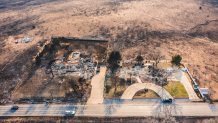
Texas Agriculture Commissioner Sid Miller estimated the number of cattle killed in the fires to be in the thousands, with more likely to come.
“There’ll be cattle that we’ll have to euthanize,” Miller said. “They’ll have burned hooves, burned udders.”
Miller said individual ranchers could suffer devastating losses, but predicted the overall impact on the Texas cattle industry would be minimal. Cattle raised in the Panhandle are largely “range cattle,” not feeder cattle that are sold to feed lots and eventually make their way to the kitchen table for consumption, he said.
Miller said any impact on the price of beef for consumers would be minimal, and at least a year away from being felt.
LARGEST WILDFIRES IN TEXAS HISTORY
- Smokehouse Creek of 2024, burning 1,075,000+ acres (active fire)
- East Amarillo Complex of 2006, burning 907,245 acres
- Big Country of 1998, burning 366,000 acres
- Perryton of 2017, burning 318,156 acres
TEXAS WILDFIRES
Sign up for our Breaking Newsletter to get the most urgent news stories in your inbox.
2011 TEXAS WILDFIRES
In April 2011, during an extreme drought, four out-of-control wildfires burning in close proximity to each other were dubbed The Possum Kingdom Complex Fire. The fires scorched 126,000 acres of parched Texas ranch land and destroyed 168 homes and two churches.
Senior Meteorologist David Finfrock said in the NBC 5 docu-series Inside the Storm: Texas Burning, that at that time the period from August 2010 to July 2011 was the driest 12 consecutive months on record.
Later that summer, in August, a second fire erupted near the lake called the PK 101 Ranch fire. That fire burned more than 6,000 additional acres on the south side of the lake and destroyed nearly 40 more homes.
On Sept. 4, 2011, a massive wildfire erupted in Central Texas. The Bastrop County Complex Fire, east of Austin, became the most destructive wildfire in Texas history. More than 1,600 homes and structures were destroyed when 32,000 acres were scorched, including 96% of the 6,565-acre Bastrop State Park. Two people died in the fires.
During that 2011 fire season, the Texas A&M Forest Service said more than 31,000 fires burned more than four million acres across the state and destroyed 2,947 homes.

